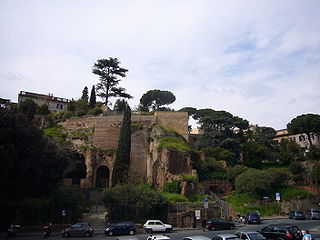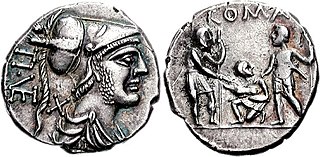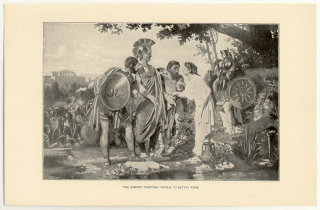
The Tarpeian Rock is a steep cliff of the southern summit of the Capitoline Hill, overlooking the Roman Forum in Ancient Rome. It was used during the Roman Republic as an execution site. Murderers, traitors, perjurors, and larcenous slaves, if convicted by the quaestores parricidii, were flung from the cliff to their deaths. The cliff was about 25 meters (80 ft) high.

The gens Veturia, originally Vetusia, was an ancient patrician family of the Roman Republic. According to tradition, the armourer Mamurius Veturius lived in the time of Numa Pompilius, and made the sacred ancilia. The Veturii occur regularly in the Fasti Consulares of the early Republic, with Gaius Veturius Geminus Cicurinus holding the consulship in 499 BC. Like other old patrician gentes, the Veturii also developed plebeian branches. The family declined in the later Republic, with the last consular Veturius holding office in 206 BC, during the Second Punic War.

The gens Lucretia was a prominent family of the Roman Republic. Originally patrician, the gens later included a number of plebeian families. The Lucretii were one of the most ancient gentes, and the wife of Numa Pompilius, the second King of Rome, was named Lucretia. The first of the Lucretii to obtain the consulship was Spurius Lucretius Tricipitinus in 509 BC, the first year of the Republic.

The gens Sicinia was a plebeian family at ancient Rome. Members of this gens occur throughout the history of the Republic, but only one of them obtained the consulship, Titus Sicinius Sabinus in 487 BC. Throughout the long Conflict of the Orders, the Sicinii were celebrated for their efforts on behalf of the plebeians.

In Roman mythology, the Battle of the Lacus Curtius was the final battle in the war between the Roman Kingdom and the Sabines following Rome's mass abduction of Sabine women to take as brides. It took place during the reign of Romulus, near the Lacus Curtius, future site of the Roman Forum. It concluded when the abducted Sabine women intervened and the two sides sued for peace.
The gens Hirtuleia was a minor plebeian family of equestrian rank at ancient Rome, which appears in history during the final century of the Republic, and under the early Empire.
The gens Nautia was an old patrician family at Rome. The first of the gens to obtain the consulship was Spurius Nautius Rutilus in 488 BC, and from then until the Samnite Wars the Nautii regularly filled the highest offices of the Roman Republic. After that time, the Nautii all but disappear from the record, appearing only in a handful of inscriptions, mostly from Rome and Latium. A few Nautii occur in imperial times, including a number who appear to have been freedmen, and in the provinces.
The gens Opsidia or Obsidia was a minor plebeian family at Rome. Few members of this gens are known to have held any magistracies, but several are found in inscriptions.
The gens Oscia was an obscure plebeian family at Rome. Members of this gens are first mentioned in imperial times, when a few of them appear among the Roman aristocracy. None of them are known to have held any magistracies, but an Oscia Modesta was the wife of a Roman consul during the time of Severus Alexander. A number of Oscii appear in inscriptions.
The gens Poetelia or Poetilia was a plebeian family at ancient Rome. Members of this gens are first mentioned in the time of the Decemvirs, and from thence down to the Second Punic War, they regularly held the chief magistracies of the Roman state. After this, however, they fade into obscurity, and are only occasionally mentioned. The nomen Poetelius is sometimes confused with Petillius, and can be found with either a single or double 'l'.
The gens Quirinia was an obscure plebeian family at ancient Rome. No members of this gens appear in history, but several are known from inscriptions.
The gens Rabuleia was a minor plebeian family at ancient Rome. Members of this gens are first mentioned in the early decades of the Republic, and Manius Rabuleius was a member of the second decemvirate in 450 BC. However, the Rabuleii subsequently fell into obscurity, and only a few of this family are known from later inscriptions.
The gens Terentilia was an obscure plebeian family at ancient Rome. Only one member of this gens appears in history; Gaius Terentilius Arsa was tribune of the plebs in 462 BC. A few others are known from inscriptions.
The gens Burbuleia, occasionally written Burboleia, was an obscure plebeian family at ancient Rome. Members of this gens are mentioned in the time of Cicero, but the only one who achieved any distinction in the Roman state was Lucius Burbuleius Optatus, consul in AD 135.
The gens Resia was an obscure plebeian family at ancient Rome. The Resii traced their ancestry to Fertor Resius, King of the Aequicoli, in the time of the Roman monarchy. However, few members of this gens are mentioned in history.
The gens Romilia or Romulia was a minor patrician family at ancient Rome. Members of this gens are mentioned in the time of the Roman monarchy, and again in the first century of the Republic. Titus Romilius Rocus Vaticanus was consul in 455 BC, and subsequently a member of the first Decemvirate in 451. From this time, the Romilii fell into obscurity for centuries, only to appear briefly in imperial times. A number of Romilii are known from inscriptions.
The gens Sibidiena, sometimes written Sabidiena, was an obscure plebeian family at ancient Rome. No members of this gens attained any of the higher offices of the Roman state, but several are known from inscriptions.
The gens Sabucia was a minor plebeian family at ancient Rome. Members of this gens are first mentioned in imperial times. The most illustrious of the family was Gaius Sabucius Major Caecilianus, who obtained the consulship in AD 186. Other Sabucii are known from inscriptions.
The gens Scantia was a minor plebeian family at ancient Rome. Few members of this gens occur in history, and none of them attained any of the higher offices of the Roman state, but a number are known from inscriptions.











